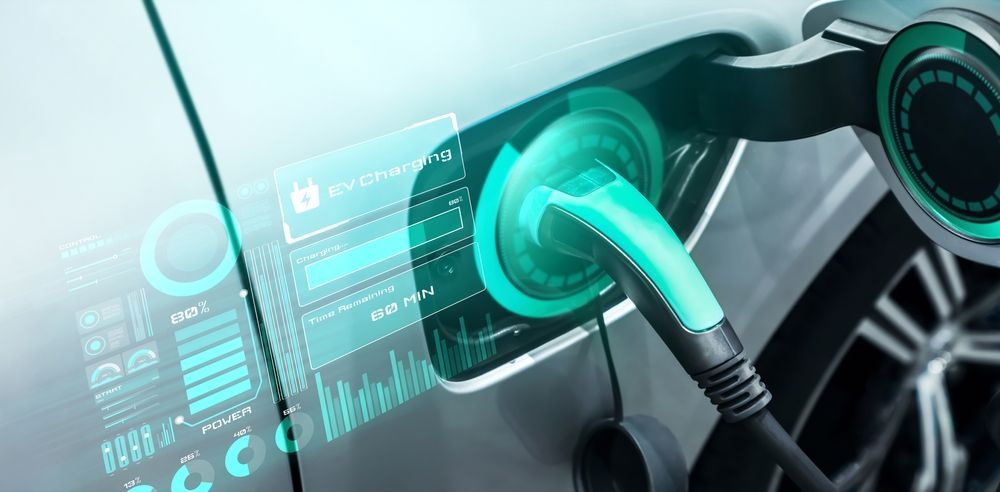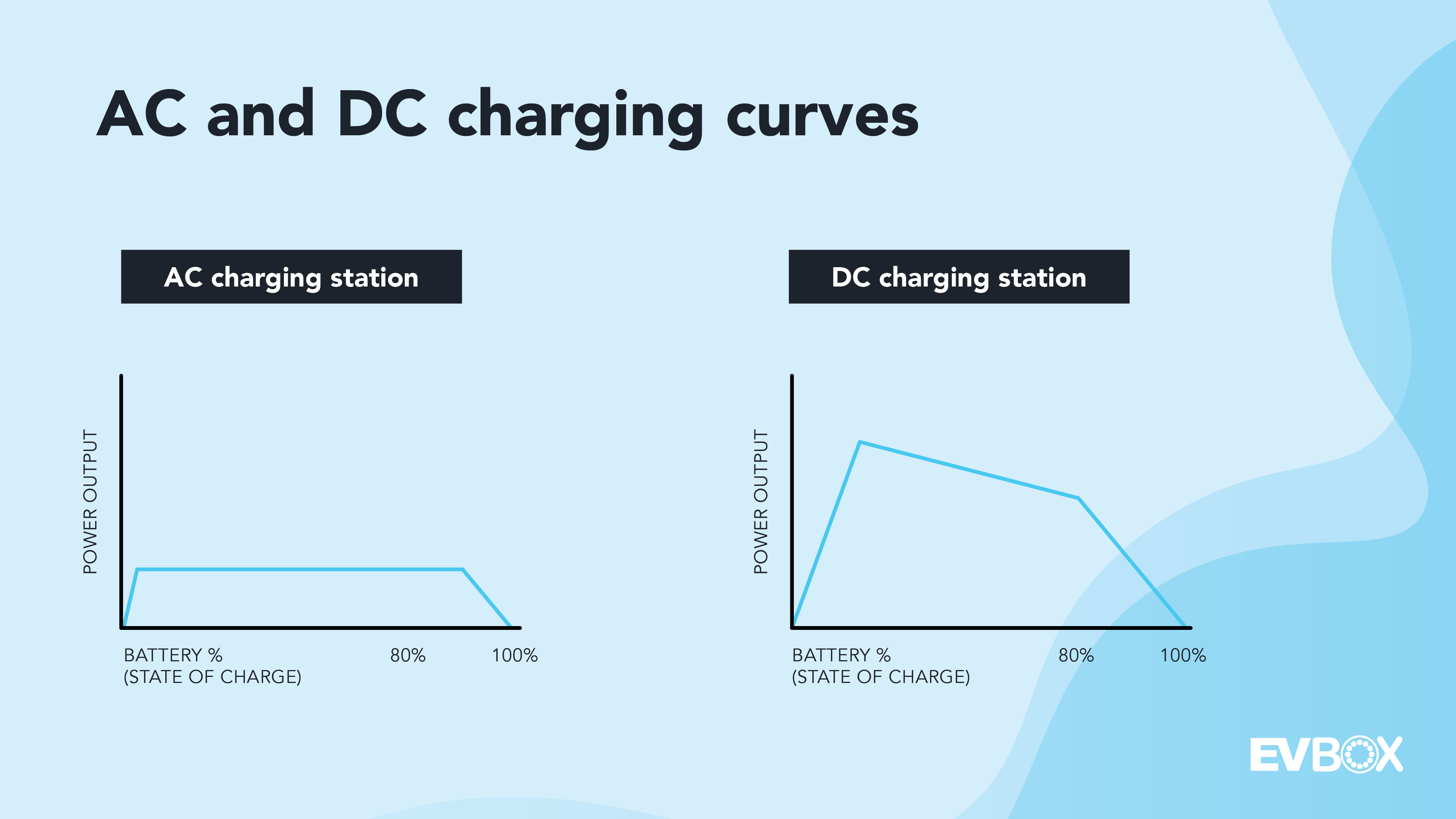On average –and depending on many different factors– it takes between three to ten hours to charge an electric car at home with an electric car charging station.
The number one question for EV drivers
One of the main advantages of EVs over traditional petrol-powered cars is the ability to charge from almost anywhere, including the home.
As home charging becomes more common, knowing the time it takes to charge an EV is one of the most important considerations for drivers. In fact, 38% of EV drivers still think charging an EV is too time-consuming.
So, how fast is an EV home charger really? And what are the factors that impact its speed? This article answers these questions and breaks down the factors influencing how quickly a charging station can charge an EV at home.

How long does it take to charge an EV at home?
As you may have guessed, an EV’s charging speed depends greatly on a number of factors, such as the charging station’s power output, your car’s battery size, and your driving behaviour, amongst others. As such, while it’s hard to predict specific numbers, we can look at average figures to get an idea.
For example, an average EV with a 64.2 kWh battery would take between three to ten hours to charge up, depending on the charger’s power output. Let’s look in more detail at the factors influencing charging speed below.
What determines the charging speed of an EV home charger?
Output power
By far the biggest determinant of charging speed is a charging station’s power output, in other words, the amount of power it can deliver to your EV’s battery. Generally, the higher the power output, the faster an EV home charger will be able to charge an EV.
Typically, home chargers have a power output of 7.4, 11, or 22 kilowatts (kW). However, you may find that depending on your national electrical grid or your home’s circuit, you may not be able to install a 22 kW or even 11 kW EV home charger, so it’s worth looking into your location’s restrictions before settling on a charging station.
However, even if you can install the fastest EV home charger, you might find that it isn’t necessary, as your car might not even be able to leverage the high power. Or your charging behaviour may not warrant getting the fastest charger possible.
For example, suppose you commute to work during the day and charge your EV overnight. Even the slowest 7.4 kW EV home charger would still provide enough power to charge a medium-sized EV to 80 percent in less than 8 hours.
Of course, actual charging times vary significantly between vehicles and can be impacted by a number of factors that we discuss below. The following table gives an overview of charging times for different power outputs and battery sizes.
Average time to charge an electric car
Type of EV | Small EV | Medium EV | Large EV |
Average battery size (right)
Power Output (below) | 25kWh | 50kWh | 75kWh |
7.4kWh | 3h 45min | 7h 45min | 10h |
11kWh | 2h | 5h 15min | 6h 45min |
22kWh | 1h | 3h | 4h 30min |
Approximate time to charge the battery from 20 percent to 80 percent state of charge (SoC). For illustrative purposes only: Does not reflect exact charging times.
Battery size
While it may seem obvious, the size of your EV’s battery is another crucial factor in determining how long it takes to charge it. You may not realise it, but EVs have an enormous range of battery sizes, going from only 21.3 kWh for the Fiat 500e to 118 kWh for the Lucid Air.
Of course, the smaller the battery, the faster an EV will charge at a given power output, and vice-versa. For instance, the Fiat 500e would charge up to 80 percent in under 2 hours using a 7.4 kW EV home charger, while it would take the Lucid Air around 10 and a half hours to achieve the same level of charge.
With the impact that battery size can have on charging times, it’s important to check beforehand how big your EV’s battery is. For instance, a Porsche Taycan (93.4 kW) or Tesla Model S (100 kW) will require considerably more power and, thus, time to charge than a Nissan Leaf (62 kW) or a Renault Zoe (54.7 kW).

State of charge
If you’ve ever researched EVs, you may have heard the term “state of charge” or “SoC” floating around. A battery’s state of charge is essentially just the amount of power it holds compared to its total capacity – in other words, the percentage of energy available at a given moment.
Because of the way battery chemistry works, a battery with a low state of charge, for example, 20% or below, will be able to receive a much higher power output than a battery with a high state of charge.
Even though home chargers (AC) don’t adjust their power outputs as much as public fast charging stations, they still need to decrease their outputs as the battery gets closer to full. This is why going from 80 to 100 percent often takes much longer than, say, going from 40 to 60 percent. Public fast charging (DC) is similar, but fast chargers adjust power output much more proactively to quickly charge up your vehicle at low states of charge.

Your car’s charging capacity
Beyond your car’s state of charge and battery capacity, another important aspect that determines charging speed is your car’s charging capacity. This is determined by the maximum power that the onboard converter is able to handle and can limit how fast your car can charge.
For instance, while most cars are capable of 7.4 kW and 11 kW charging, many EV models don’t have an onboard converter capable of 22 kW charging. As such, even if your EV home charger is capable of 22 kW charging, you may not be able to use all that power if your EV is incompatible.
Driving behaviour
The main factor that influences a battery’s state of charge, and thus the power output it’s capable of receiving at a given moment, is driving behaviour, specifically how much you drive. Indeed, depending on the length of your commute, you could have to charge your car daily, every other day, or only a couple of times per week.
Given that an EV consumes, on average, 0.20 kWh per kilometre, or 0.32 kWh per mile, let’s look more closely at the average electricity consumption an EV home charger requires to cover the daily commute for the English, American and Europeans.
The UK Department of Transport reported in 2020 that the average driver in England travels 4,334 miles a year or 11.87 mi a day. A home charger would need around 3.8 kWh per day to cover the average daily commute. This would take 30 mins to charge with a 7.4 kW EV home charger, 21 mins with an 11 kW charger, and 10 mins with a 22 kW.
According to the U.S. Department of Transportation, Americans drive on average 13,476 miles per year or 36.92 mi per day. This means that an EV home charger requires around 11.81 kWh per day to cover Americans’ average daily driving distance. This would take 1h 50 mins to charge with a 7.4 kW EV home charger, 1h 18 mins with an 11 kW charger, and 43 mins with a 22 kW one.
To calculate the same data for Europe, consider that Europeans drive on average 2814 miles per year or 7.7 mil per day. In this case, an EV home charger needs around 2.48 kWh per day to cover the average daily European driving distance. This would take 23 mins to charge with a 7.4 kW EV home charger, 16 mins with an 11 kW charger, and 9 mins with a 22 kW one.

Weather conditions
Finally, environmental conditions, such as temperature, can impact charging speed. This is because batteries operate optimally in a narrow range of temperatures, roughly between 20–25°C (68–77°F). Anything significantly higher or lower can negatively impact charging times.
Indeed, if temperatures are too high or too low, the car will have to use some of the energy from charging to heat or cool the battery, reducing the amount of energy actually used to charge the battery. In some cases, the vehicle’s Battery Management System (BMS) even reduces charging power to protect the battery, further slowing charging.
As such, you might notice slower charging during the summer or winter months, when temperatures are furthest from ideal. Of course, this depends greatly on where your EV home charger is installed, and you might not see much difference if it is mounted inside a garage, for example.

What else should you know about EV home charging?
Unlike refuelling a petrol or diesel powered car, charging speed is an important consideration for electric vehicles. While charging speed varies on a range of factors, the most important determinant is the charging output that your EV home charger provides, and is on top of many people’s lists when choosing between charging stations.
Having a home charging station allows for much faster charging speeds than charging without one. But there's more to it. We've written a complete and free guide to tell you more about EV home chargers; their average price, how to install one, why it is the safest way to go, and other factors you may want to take into account.